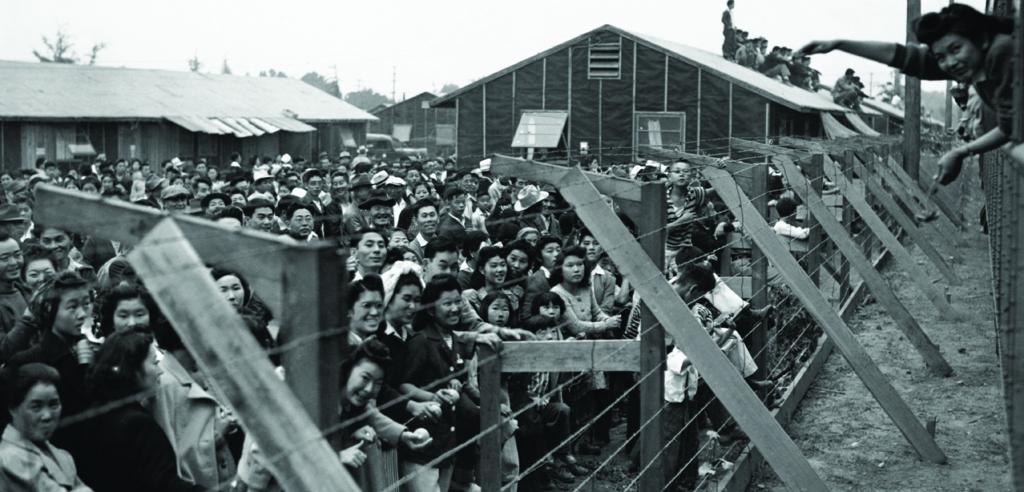Government of thousands of Japanese Americans to detention camps during World War II. From 1942 to 1945 it was the policy of the US.
 What Japanese American Internment Camps And Family Separations Have In Common Quartz
What Japanese American Internment Camps And Family Separations Have In Common Quartz
United States led to a Supreme Court ruling in 1944 that the evacuation and internment of Nisei was constitutional.

Internment of japanese americans. Fords Proclamation 4417 Speech Confirmation of the Termination of the Executive Order Authorizing Japanese-American Internment During World War II Gerald R. Over 120000 Japanese Americans were held in incarceration campstwo-thirds of whom were US-born citizens. Fear not evidence drove the US.
Volunteers to relocate were minimal so the executive order paved the way for forced relocation of Japanese-Americans living on the west coast. Roosevelt signs Executive Order 9066 initiating a controversial World War II. Born in Hayward California in 1939 she spent most of World War II interned with her family at a camp in Utah.
John Tateishi now 81 was incarcerated at the Manzanar internment camp in California from ages 3 to 6. At first the relocations were completed on a voluntary basis. That action was the culmination of the federal governments long history of racist and discriminatory treatment of Asian immigrants and their descendants that had begun with restrictive immigration policies in the late 1800s.
Japanese Americans who were interned were significantly less likely to report interest in politics even two decades after World War II than those who were not interned. The Internment of Japanese Americans as reported by Seattle Area Weekly Newspapers by Luke Colasurdo. Government that people of Japanese descent would be interred in isolated camps.
After the war ended Tateishi and his family returned to Los Angeles where Tateishi says. Japanese American internment the forced relocation by the US. On February 19 1942 President Franklin D.
The War Relocation Authority the Incarceration of Japanese-Americans During World War II. Tom Kobayashi stands in the south fields of the Manzanar Relocation Center at the foot of the Sierra Nevada Mountains in Californias Owens Valley in 1943. To place over 127000 Japanese-Americans in concentration camps for the duration of WWII.
FDR and Japanese American Internment. In an effort to curb potential Japanese espionage Executive Order 9066 approved the relocation of Japanese-Americans into internment camps. Enacted in reaction to.
Famed photographer Ansel Adams. Roosevelt signed Executive Order 9066 authorizing the US Army to remove all persons of Japanese ancestry from the West Coast and imprison them without due process of law. Such artifacts make the internment real to people says Korematsu who talked with Truthdig writer Emily Wilson about how Japanese-Americans were temporarily housed in.
Fords Remarks Upon Signing Proclamation 4417. FDR orders Japanese Americans into internment camps On February 19 1942 President Franklin D. The roundup and internment of Japanese American citizens led to a few peaceful protests as well as several legal fights.
Meanwhile however the government had begun to investigate Japanese Americans more closely and concluded that some. One legal battle the case of Korematsu v. Many Americans worried that citizens of Japanese ancestry would act as spies or saboteurs for the Japanese government.
A roster of 104000 people of Japanese heritage sent to US internment camps. Seventy-five years after the fact the federal governments incarceration of some. Over 127000 United States citizens were imprisoned during World War II.
PDF plaintext txt Excel spreadsheet CSV file During World War II in what is often called one of the darkest chapters in US history people of Japanese ancestry - naturalized US citizens US-born citizens and Japanese citizens - were forcibly removed from their homes and put into concentration camps in.
 California To Apologize For Internment Of Japanese Americans
California To Apologize For Internment Of Japanese Americans
 Wisconsinite Shares His Family S Experience In Japanese American Internment Camps Wisconsin Public Radio
Wisconsinite Shares His Family S Experience In Japanese American Internment Camps Wisconsin Public Radio

 California Plans To Apologize To Japanese Americans Over Internment The New York Times
California Plans To Apologize To Japanese Americans Over Internment The New York Times
 Japanese Internment Camps Wwii Life Conditions History
Japanese Internment Camps Wwii Life Conditions History
 Lessons From A Japanese Internment Camp
Lessons From A Japanese Internment Camp
 Rarely Seen Photos Of Japanese Internment The New York Times
Rarely Seen Photos Of Japanese Internment The New York Times

 At Least During The Internment Are Words I Thought I D Never Utter Foreign Policy
At Least During The Internment Are Words I Thought I D Never Utter Foreign Policy
Popular Posts
-
This is a list of the 100 most populous counties in the United States based on the national decennial US census conducted on April 1 2010 an...
-
He ruled from 5 April 1462 to 27 October 1505 he was known as Ivan the Great and was a Grand Prince of Moscow. 29 October 1603 Moscow Russia...
-
Indian National Congress 1885. N the official name for Congress3 Collins English Dictionary Complete and Unabridged 12th Edition 2014 Harper...
Featured Post
eyes but cannot see verse
83 Bible Verses about Have Eyes But Do Not See . “Son of man, you dwell in the midst of a rebellious house, who have eyes to see, but ...

ads
